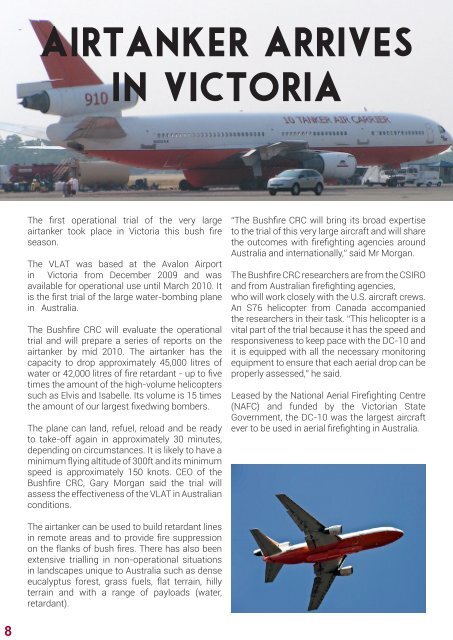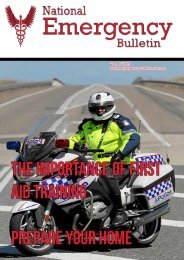Emergency Dispatch Vol 4 2014
You also want an ePaper? Increase the reach of your titles
YUMPU automatically turns print PDFs into web optimized ePapers that Google loves.
8<br />
AIRTANKER ARRIVES<br />
IN VICTORIA<br />
The first operational trial of the very large<br />
airtanker took place in Victoria this bush fire<br />
season.<br />
The VLAT was based at the Avalon Airport<br />
in Victoria from December 2009 and was<br />
available for operational use until March 2010. It<br />
is the first trial of the large water-bombing plane<br />
in Australia.<br />
The Bushfire CRC will evaluate the operational<br />
trial and will prepare a series of reports on the<br />
airtanker by mid 2010. The airtanker has the<br />
capacity to drop approximately 45,000 litres of<br />
water or 42,000 litres of fire retardant - up to five<br />
times the amount of the high-volume helicopters<br />
such as Elvis and Isabelle. Its volume is 15 times<br />
the amount of our largest fixedwing bombers.<br />
The plane can land, refuel, reload and be ready<br />
to take-off again in approximately 30 minutes,<br />
depending on circumstances. It is likely to have a<br />
minimum flying altitude of 300ft and its minimum<br />
speed is approximately 150 knots. CEO of the<br />
Bushfire CRC, Gary Morgan said the trial will<br />
assess the effectiveness of the VLAT in Australian<br />
conditions.<br />
“The Bushfire CRC will bring its broad expertise<br />
to the trial of this very large aircraft and will share<br />
the outcomes with firefighting agencies around<br />
Australia and internationally,” said Mr Morgan.<br />
The Bushfire CRC researchers are from the CSIRO<br />
and from Australian firefighting agencies,<br />
who will work closely with the U.S. aircraft crews.<br />
An S76 helicopter from Canada accompanied<br />
the researchers in their task. “This helicopter is a<br />
vital part of the trial because it has the speed and<br />
responsiveness to keep pace with the DC-10 and<br />
it is equipped with all the necessary monitoring<br />
equipment to ensure that each aerial drop can be<br />
properly assessed,” he said.<br />
Leased by the National Aerial Firefighting Centre<br />
(NAFC) and funded by the Victorian State<br />
Government, the DC-10 was the largest aircraft<br />
ever to be used in aerial firefighting in Australia.<br />
The airtanker can be used to build retardant lines<br />
in remote areas and to provide fire suppression<br />
on the flanks of bush fires. There has also been<br />
extensive trialling in non-operational situations<br />
in landscapes unique to Australia such as dense<br />
eucalyptus forest, grass fuels, flat terrain, hilly<br />
terrain and with a range of payloads (water,<br />
retardant).





